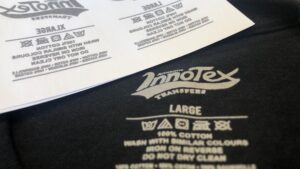So, you’re either looking to create some printed garments, a business in need of a dinky product to take on the go, or a corporation looking for the best machine for all your material needs. Whatever you’re looking for, we’ve got you covered. We’ve outlined the different types of heat press machines and the best type of use for each one.
What is a heat press machine?
A heat press machine is designed to imprint design onto the underlying later. It uses flat platen to apply pressure and heat to transfer graphics or designs.
Are there different types of heat press machines?
Yes there are! Each type of heat press machines have their own functions and benefits. Some can print on polyester and cotton, whereas some can print on mugs, bags, hats etc. They are called clamshell, swing away, draw and sublimation machines.
What is a transfer paper?
The required design is first printed on transfer paper – a sheet with pigments and wax. Depending on the types of printers, there are numerous types of transfer papers.
How can a heat press machine be used on t-shirts?
A heat press machine is usually set to the desired temperature, depending on the type of transfer paper used. This is usually between 176 – 190° celsius. The T-shirt is laid out on the surface area. Transfer paper with the design facing down is then placed on top of the t-shirt. Hot platens or plates are then pressed on the t-shirt for 5 – 10 seconds. The design is then transferred from transfer paper to the t-shirt. It is recommended to leave the final product for a few hours to let the print set in.
What is the cost of a heat press machine in the UK?
Like all supplies and machinery, heat press machines vary in prices. They are available for small and medium enterprises. The price stretches between £160 – £5000. Let’s take a look at each machine in detail.
What is a clamshell press?
This machine gets its name from the movement during the heat press process. It is hooked by one end and opens and closes on the garment like a clam. It is also portable, so you don’t need much space to carry out your tasks. There aren’t many moving parts either, so beginners can print thin garments easily. I’d recommend wearing gloves to avoid injuries as there’s the risk of getting burned. Overall, it is one of the cheaper machines out there, ranging between £1,000 – 2,500 and more cost effective as it doesn’t use as much electricity.
What is a swing away press?
Unlike the clamshell, a swing away machine has much more movement to it, swinging back and forth between 180 – 360º. You’ll need more room to carry out projects and its quite heavy, meaning it’s not portable. The process is time consuming, however, there’s no risk of injury so long as you keep out of the machine’s way – you don’t need to get directly involved with the transfer process. Swing away machines range from £1,600 – 5,000, so it is a bigger investment for the user/business. Also, electricity consumption is high, meaning a bigger bill.
What is a draw/pull-out press?
This heat press machine is also called ‘pull out’, which lets you pull out the moveable lower platen to have more workspace to arrange the garment. You can easily place your t-shirts without having to stress about the heated platen. This machine gives you a full view of the layout area without consuming much space. Unlike other heat presses, the hydraulic mechanism in this machine ensures smooth opening/closing. The price of a draw heat press machine can range between £160 to £1,000.
What is a sublimation/mug press?
Like any other heat press machines, the sublimation heat press machine allows you to embed designs into the fabric using heat. The final print is long-lasting and is mainly used on hard materials like mugs, jewellery, metal, etc. But it can only apply prints on garments with 50% or more polyester. This type of heat press machine has a wide surface area which enables you to transfer artwork on large items. Overall, it is a multi-purpose heat transfer. Price of this machine and range from £160 to £800.
Does a heat press machine work better than an iron?
Now that we’ve established what each type of heat press can do, let’s take a look at what an iron can do and whether it matches up or even surpasses that of a professional result. With that in mind, it’s best to list this out in a pros and cons format.
Pros
- Best used for ordinary garment printing, (t-shirts, hoodies, shirts etc.) Those who simply wish to spice up plain garments can easily print designs.
- Iron printing can be completed anywhere as long as you a flat surface with coverings to avoid burns.
- Limited equipment required (an inkjet printer and transfer paper).
- Much cheaper than purchasing a machine.
- Results can withstand many cycles in the wash.
Cons
- Irons aren’t professional heat presses (it’s vital to set the iron to the right temperature)
- Good pressure and timing on the application required (printing can be tricky if the heat press hasn’t been left on long enough).
- The user’s full attention is required for each step
- Results may deteriorate after excessive washing.
The thing about iron printing is that it ACTS as a heat press. It’s not a professional tool recommending for business use because results can vary (trial and error may be needed). Over time it’s easy to figure out a concise method, however, irons don’t have features like most presses, including temperature and time settings.
It’s fair to say that iron printing is good for individuals who look to style their wardrobe, but for business use, it’s recommended to invest in a low-cost heat press machine at the very least, as iron printing is experimental and not guaranteed to satisfy consumers.
Contact Innotex Transfers for more info!
Now that you’re full of knowledge, get out there and find yourself a heat press machine! Innotex Transfers is here to ease your printing process steps, so all you need to do is press and peel! Call or email us for a quote on your exact size and quantity requirements.

How to Wash Printed T-shirts: Aftercare Instructions
Previously we’ve covered various topics surrounding printing on t-shirts. Some being avoiding dye migration and even managing the artwork itself before

Transfer Paper For Heat Press Machine
Transfer paper for a heat press machine is vital to ensure your print comes out in high quality, smooth finish.

A Beginner’s Guide to Clothing Labels
Are you a small business owner, or have you always wanted to start your own independent clothing brand? Imagine putting


